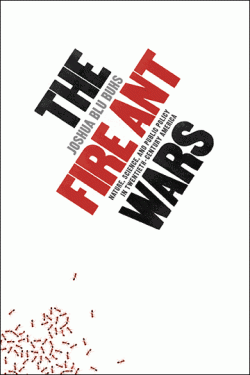The Fire Ant Wars: Nature, Science, and Public Policy in Twentieth-Century America (University of Chicago Press, 2004)

The book examines controversies over attempts to control the red imported fire ant (Solenopsis invicta) in the American South from the late 1940s into the 1990s. Solenopsis invicta itself slipped into the country sometime in the late 1930s or early 1940s, most likely through the port of Mobile.
It remained relatively benign for several years, mostly, I argue, because the landscape was not much to its liking. That changed in the decades after World War II. The ant prefers disturbed, open habitat, and there came to be a lot of the in the post-War period, as the so-called bulldozer revolution remade the American South into a part of the Sunbelt. Suddenly, there were tracts of homes, factory farms, huge cattle pastures, and parks where once it had been overgrown wastelands.
As the insect spread, it caused problems--its mounds interfering with tractors, its sting sometimes killing wildlife, and often hurting people. It occasionally killed humans, too.
Solenopsis invicta's spread also brought the ant into contact with scientists in the USDA's Plant Pest Protection Agency, who were just then imagining that new chemicals that helped to win the War--DDT, chlordane, dieldrin, and the like--could be used to not only control insects, but to completely eradicate them.
At the same time, post-War prosperity was making Americans more aware of the environment: increased wages meant that they could now demand that their air be fresh, their water clean, their forests unmolested.
These two groups, the optimists in the PPC and members of the emerging environmental movement, clashed over the ant eradication programs. Their battle--more than attempts to control Solenopsis invicta--make up the fire ant wars. And the results of those battles have shaped the world in which we now live.
Reprints
"Grins a Prohibitive Fracture," pp. 41-46, in Short Stories for Students, vol. 32 (Cengage/Gale, 2011).
Reviews
Nell Linton Knox, "Reading Response," Studying the Southern Environment 18 November 2010.
José Augusto Drummond, Revista Brasileira de Historia 28 (2008): no. 55.
Pete Daniel, Agricultural History 80 (2006): 375-6.
Scott Dewey, Journal of Southern History 72 (2006): 212-213.
John H. Perkins, Technology & Culture 47 (2006): 451-2.
Ari Kelman, Isis 97 (2006): 375-376.
Daniel Simberloff, Biological Invasions 8 (2006): 291-2.
Annie E. Lamb, Bulletin of the British Ecological Society 36:3 (2005): 49-50.
Matt Bright, Environmental Politics 14 (2005): 740-1
C. Ronald Carroll, "The Invincible Fire Ant," Ecoscience 12 (2005): 581.
Frederick R. Davis, Journal of the History of Biology 38 (2005): 620-622.
Alan Marshal, "Ants/Anti-Ants," Metascience 14 (2005): 209-11.
Sterling Evans, Environmental Conservation 32 (2005) 189-90.
Brian Drake, "Science, Bureaucracy, and the South's Red Menace," H-Environment December 2005.
Donald H. Feener Jr., "Burning Ambitions: The Science and Politics of Fire Ant Control," Ecology 86 (2005): 1958-9.
Gaden S. Robinson, 'Natural History' Times Literary Supplement 1 April 2005.
Commentary
Ed Darrell, "100 things about DDT: Dissecting #10," Millard Fillmore's Bathtub 8 November 2007.
Benjamin Cohen, "From Ants and Heptachlor to Mercury and Global Warming, the Same Racket," The World's Fair, Scienceblogs 24 May 2007.
Brett L. Walker, "Animals and the Intimacy of History," Conference Paper, Temple University.
Related Material, by others
Nathan J. Sanders and Andrew V. Suarez, "Elton's Insights into the Ecology of Ant Invasions: Lessons Learned and Lessons Still to Be Learned," in David M. Richardson, Fifty Years of Invasion Ecology: The Legacy of Charles Elton (Oxford: Wiley-Blackwell, 2011), 239-252.
Rachel Natalie Mason Dentinger, "The Nature of Defense: Coevolutionary Studies, Ecological Interaction,and the Evolution of 'Natural Insecticides,' 1959-1983," Dissertation, University of Minnesota, 2009.
Alfredo Flores, 'Fire Ant Outcompetes Other Species—Even in its Native Habitat,' USDA ARS News and Events 2 July 2009.
Daniel Simberloff, "We Can Eliminate Invasions or Live with Them. Successful Management Projects," Biological Invasions 11 (2009):149–157.
Joshua R. King and Walter Tschinkel, "Experimental Evidence That Human Impacts Drive Fire Ant Invasions and Ecological Change," Proceedings of the National Academy of Sciences 105 (2008): 20339–20343.
Philip S. Ward, "Edward O. Wilson and his Contributions to Ant Systematics," Advances in Ant Systematics (Hymenoptera: Formicidae): Homage to E. O. Wilson – 50 Years of Contributions. Memoirs of the American Entomological Institute, 80 (2007): 3-7.
Joseph M. Raczkowski and John W. Wenzel, "Biodiversity Studies and Their Foundation in Taxonomic Scholarship," Bioscience 57 (2007): 974-979.
Ann Villeisis, Kitchen Literacy: How We Lost Knowledge of Where Food Comes from and Why We Need to Get It Back, Island Press, 2007.
Paul S. Sutter, "Nature's Agents or Agents of Empire: Entomological Workers and Environmental Change during the Construction of the Panama Canal," Isis 98 (2007): 724-754.
Arn M. Keeling, "Charting Marine Pollution Science: Oceanography on Canada's Pacific Coast, 1938–1970," Journal of Historical Geography 33 (2007): 403-428.
Robert R. Dunn, "Book Review: A Plague of Rats and Rubbervines," Biological Invasions 8(2006): 393-394.
Albert G. Way, 'Burned to Be Wild: Herbert Stoddard and the Roots of Ecological Conservation in the Southern Longleaf Pine Forest,' Environmental History 11 (2006).
Shane Hamilton, "Poisons in the Land," Reviews in American History 34 (2006) 64–71.
J. L. Anderson, "War on Weeds: Iowa Farmers and Growth-Regulator Herbicides," Technology and Culture 46 (2005): 719-744.
B.M. H. Larson, "The War of the Roses: Demilitarizing Invasion Biology," Frontiers in Ecology and the Environment 3 (2005): 495-500.
